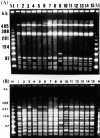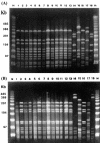Dynamics of long-term colonization of respiratory tract by Haemophilus influenzae in cystic fibrosis patients shows a marked increase in hypermutable strains
- PMID: 15070988
- PMCID: PMC387613
- DOI: 10.1128/JCM.42.4.1450-1459.2004
Dynamics of long-term colonization of respiratory tract by Haemophilus influenzae in cystic fibrosis patients shows a marked increase in hypermutable strains
Abstract
The persistence and variability of 188 Haemophilus influenzae isolates in respiratory tract of 30 cystic fibrosis (CF) patients over the course of 7 years was studied. Antibiotic susceptibility testing, DNA fingerprinting, and analysis of outer membrane protein profiles were performed on all isolates. A total of 115 distinct pulsed-field gel electrophoresis profiles were identified. Ninety percent of patients were cocolonized with two or more clones over the studied period. A third of the patients were cross-colonized with one or two H. influenzae strains; 11% of the clones persisted for 3 or more months. Biotype, outer membrane protein profiles, and resistance profiles showed variation along the studied period, even in persisting clones. Four isolates (2.1%) recovered from 3 patients were type f capsulate, with three of them belonging to the same clone. beta-Lactamase production was detected in 23.9% of isolates while 7% of the beta-lactamase-negative isolates presented diminished susceptibility to ampicillin (beta-lactamase-negative ampicillin resistance phenotype). Remarkably, 21.3% of the H. influenzae isolates presented decreased susceptibility to ciprofloxacin, which was mainly observed in persisting clones. Of the H. influenzae isolates from CF patients, 18 (14.5%) were found to be hypermutable in comparison with 1 (1.4%) from non-CF patients (P < 0.0001). Ten patients (33.3%) were colonized by hypermutable strains over the study period. A multiresistance phenotype and long-term clonal persistence were significantly associated in some cases for up to 7 years. These results suggest that H. influenzae bronchial colonization in CF patients is a dynamic process, but better-adapted clones can persist for long periods of time.
Figures





References
-
- Barenkamp, S. J., R. S. Munson, Jr., and D. M. Granoff. 1981. Subtyping isolates of Haemophilus influenzae type b by outer membrane protein profiles. J. Infect. Dis. 143:668-676. - PubMed
-
- Bilton, D., A. Pye, M. M. Johnson, J. L. Mitchell, M. Dodd, A. K. Webb, R. A. Stockley, and L. Hill. 1995. The isolation and characterization of non-typeable Haemophilus influenzae from the sputum of adult cystic fibrosis patients. Eur. Respir. J. 8:948-953. - PubMed
-
- Campos, J., F. Román, M. Pérez-Vázquez, B. Aracil, J. Oteo, and E. Cercenado. 2003. Antibiotic resistance and clinical significance of Haemophilus influenzae type F. J. Antimicrob. Chemother. 52:961-966. - PubMed
-
- Campos, J., F. Román, M. Georgiou, C García, R. Gómez-Lus, R. Cantón, and H. Escobar, F. Baquero. 1996. Long-term persistence of ciprofloxacin-resistant Haemophilus influenzae in patients with cystic fibrosis. J. Infect. Dis. 174:1345-1347. - PubMed
Publication types
MeSH terms
Substances
LinkOut - more resources
Full Text Sources
Other Literature Sources
Medical
Molecular Biology Databases

